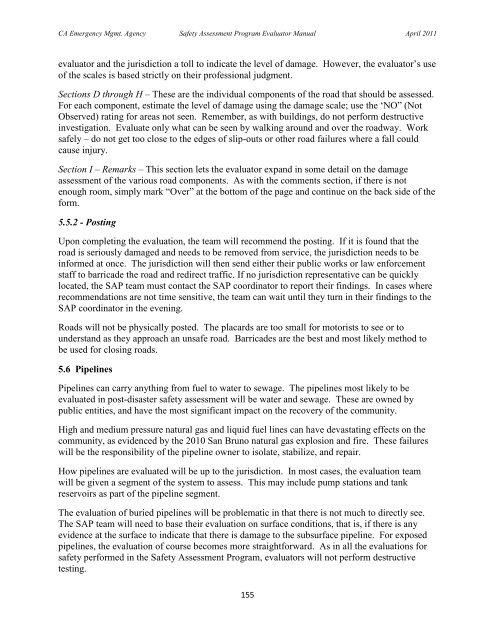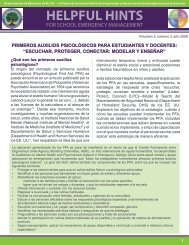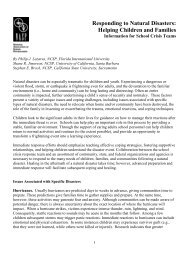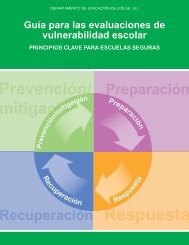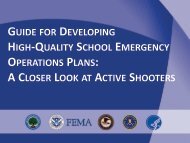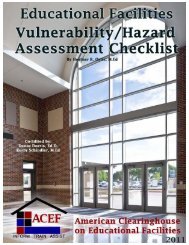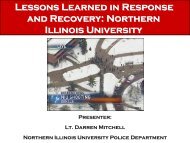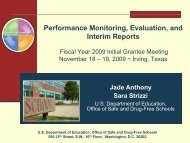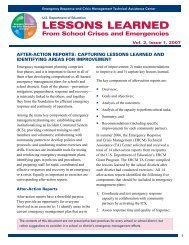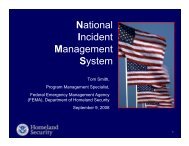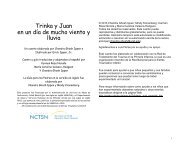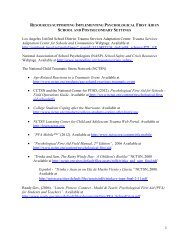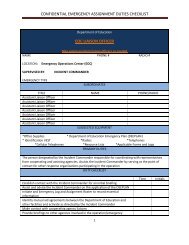Safety Assessment Program Evaluator Student Manual
Safety Assessment Program Evaluator Student Manual
Safety Assessment Program Evaluator Student Manual
You also want an ePaper? Increase the reach of your titles
YUMPU automatically turns print PDFs into web optimized ePapers that Google loves.
CA Emergency Mgmt. Agency <strong>Safety</strong> <strong>Assessment</strong> <strong>Program</strong> <strong>Evaluator</strong> <strong>Manual</strong> April 2011evaluator and the jurisdiction a toll to indicate the level of damage. However, the evaluator‟s useof the scales is based strictly on their professional judgment.Sections D through H – These are the individual components of the road that should be assessed.For each component, estimate the level of damage using the damage scale; use the „NO” (NotObserved) rating for areas not seen. Remember, as with buildings, do not perform destructiveinvestigation. Evaluate only what can be seen by walking around and over the roadway. Worksafely – do not get too close to the edges of slip-outs or other road failures where a fall couldcause injury.Section I – Remarks – This section lets the evaluator expand in some detail on the damageassessment of the various road components. As with the comments section, if there is notenough room, simply mark “Over” at the bottom of the page and continue on the back side of theform.5.5.2 - PostingUpon completing the evaluation, the team will recommend the posting. If it is found that theroad is seriously damaged and needs to be removed from service, the jurisdiction needs to beinformed at once. The jurisdiction will then send either their public works or law enforcementstaff to barricade the road and redirect traffic. If no jurisdiction representative can be quicklylocated, the SAP team must contact the SAP coordinator to report their findings. In cases whererecommendations are not time sensitive, the team can wait until they turn in their findings to theSAP coordinator in the evening.Roads will not be physically posted. The placards are too small for motorists to see or tounderstand as they approach an unsafe road. Barricades are the best and most likely method tobe used for closing roads.5.6 PipelinesPipelines can carry anything from fuel to water to sewage. The pipelines most likely to beevaluated in post-disaster safety assessment will be water and sewage. These are owned bypublic entities, and have the most significant impact on the recovery of the community.High and medium pressure natural gas and liquid fuel lines can have devastating effects on thecommunity, as evidenced by the 2010 San Bruno natural gas explosion and fire. These failureswill be the responsibility of the pipeline owner to isolate, stabilize, and repair.How pipelines are evaluated will be up to the jurisdiction. In most cases, the evaluation teamwill be given a segment of the system to assess. This may include pump stations and tankreservoirs as part of the pipeline segment.The evaluation of buried pipelines will be problematic in that there is not much to directly see.The SAP team will need to base their evaluation on surface conditions, that is, if there is anyevidence at the surface to indicate that there is damage to the subsurface pipeline. For exposedpipelines, the evaluation of course becomes more straightforward. As in all the evaluations forsafety performed in the <strong>Safety</strong> <strong>Assessment</strong> <strong>Program</strong>, evaluators will not perform destructivetesting.155


